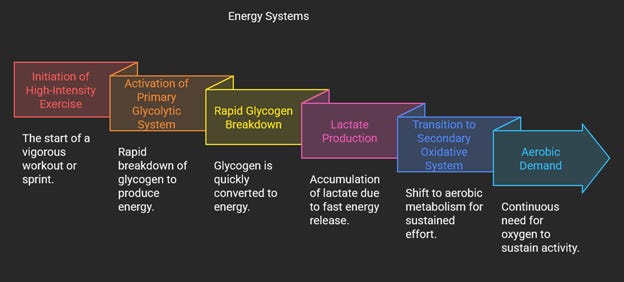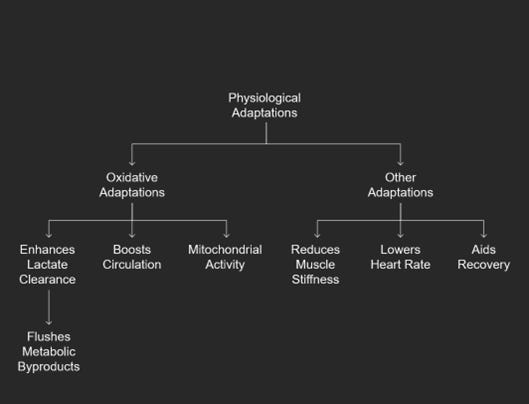The Science of Speed: Unlocking the Three Energy Systems for Swimming Success
Ever wonder what makes a swimmer propel through the water- whether it’s a lightning fast 50m dash or a grueling 1500m swim? It’s not just grit or talent; it’s energy, pure and simple, orchestrated by three remarkable systems in the body. These forces turn good swimmers into great ones. In this deep dive, we’ll unpack the science behind every stroke- immediate bursts, glycolytic battles, and oxidative endurance and show you how to harness them for success. Ready to fuel your swimming obsession? Let’s jump in!
Improving the Immediate Energy System (ATP-PCr)
Description: This system is a sprinter’s nitrous boost- potential power, and power with a drain for the starts, turns, and brief dashes like the 25m, like 10-15 seconds or less. It draws from the local ATP and phosphocreatine (PCr) stores (in muscles), with no need for oxygen, for unadulterated, explosive speed.
Training Methods (sample):
- Sprints (15-50m) max speed, 3-5 min recovery. This repetitions & rest allow the swimmer to re-engage the ATP-PCr system with near recovery of phosphagen stores- directly challenges the system's ability to generate quick outputs of energy.
- Each set, explosive starts and turns, 1-2 minutes recovery-these actions require the generation of maximal force over a short length of time
- You hit them with heavy weight, low-rep resistance (say 5 squats)-has been shown to increase muscle ATP and PCr stores, as well as creatine kinase efficiency for the regeneration of PCr. This indirectly enhances the contribution of the ATP-PCr system to swimming power!"
Physiological Adaptations:
- Larger ATP/PCr stores in muscles
- More rapid creatine kinase for ATP replenishment- Training upregulates the creatine kinase enzyme, facilitating the immediate resynthesis of ATP from PCr during sustained exercise
- Quick firing & recruitment of Type IIx fibers. Fast, strong contractions depend most on Type IIx fibers
- Some Type IIx fiber growth (hypertrophy/ increase in muscle size)- indirectly. Though strength in its purest form appears to be the driving factor, there is potential for at least some hypertrophy of type IIx fibers because of the swimmer considerations affecting maximal power. This hypertrophy is indirectly through the demands associated with repeated bouts of maximal effort over a period of approximately 90 seconds to 2-3 minutes or less.
Takeaways: Coaches: Concentrate on rapid, all-out activities with long breaks- attempt 8x25m sprints with 3-minute gaps. To develop that explosive edge, it’s quality over quantity.
Takeaways: Swimmers: Go 100% on every sprint or start, then rest completely - you’ll have more power each time you come back. Feel the burst grow!
Takeaways: Administrators: Make dryland gear such as weights a serious investment- those 5-rep lifts will boost sprint times and give your team a competitive edge.
Takeaways: Parents: Make sure you have a quick carb snack (for example, a banana) before practice- it’s like rocket fuel for these bursts. Cheer those fast starts!
Improving and targeting the Glycolytic System (Anaerobic)
Description: Think of it as a race-car engine, revving powerfully over 50m, 100m or portions of a 200m race- 10 seconds to 2 minutes of high-octane exertion. It burns carbs (glycogen) rapidly, without oxygen, creating the lactate- that “burn” swimmers fight through with determination. This system is trained through multiple high-intensity work efforts interspersed with short recovery periods, with lactate accumulation
Training Methods (sample):
- 6-10 x 50m or 4-8 x 100m, 30-60 sec rest-Repeated Short-Term High-Intervals with Incomplete Recovery. Workout intervals performed at near-maximal effort, with incomplete recovery (<1–2 min between work bouts) activating the glycolytic system.
- 200s at high intensity, 1–2 min takes a rest. These are longer Anerobic Intervals and are highly glycolytic- using the glycolytic system and taking the swimmer to their ability to sustain power with high lactate concentrations.
- Elevated lactate sets-Sets pushing the swimmer to very high lactate levels and maintaining effort while the swell and fatigue hurt should improve the body’s ability to function under acidic conditions.
Physiological Adaptations:
- Enhanced glycolytic enzymes when ATP-Training can increase the activity of enzymes that play a significant role in the metabolism of glycogen to ATP, thus raising the maximal capacity of the system to produce ATP.
- Improved pH control via enhanced lactate buffering. The body can get better at tolerating the acid produced during glycolysis, which allows the muscle to maintain a more optimal pH for a longer duration in the muscle during high-intensity exercise.
- Tougher Type IIa fibers- Resistance of Type IIa. These fibers are capable of both glycolytic and oxidative metabolism and ultimately largely play an important role in the maintenance of high-intensity swimming. Training could enhance their recruitment patterns and resistance to fatigue during glycolytic-dominant activities.
- Higher glycogen stores (paired with carbs)-Regular high-intensity training (particularly with a carbohydrate diet) can maximize the amount of glycogen stored in the muscle fibers to provide a greater supply of the fuel source for the glycolytic pathway
- More rapid lactate removal (oxidation, Cori cycle)- Training can improve the capacity of the body to remove lactate from the muscles and the blood, either via its oxidation in other muscle fibers or via its regeneration in glucose in the liver (Cori cycle). This makes swimmers better recover between high intensity efforts and may allow them to sustain higher speeds throughout.
Takeaways: Coaches: Add intensity with short-rest intervals- 6x50m with 30 seconds off builds toughness. Teach them to love the burn- it’s the name of the game!
Takeaways: Swimmers: Push through even as it burns- that lactate is your effort "medal". You’re teaching your body to fight longer and recover quicker.
Takeaways: Administrators: Planned meets with short turnarounds- these sets help swimmers prepare for racing back-to-back, and really do the trick.
Takeaways: Parents: Post-swim, carbs refill that fuel tank - your swimmer’s ready to head into the next workout sooner!
Improving the Oxidative System (Aerobic)
Description: This is the turbo diesel of 400m, 800m, 1500m or open water swims- 2 minutes and over. It burns carbs, fats- even lactate, using oxygen to provide a steady stream of ATP for those long, grueling races.
Training Methods (sample):
- Moderate to low pace swims, longer durations (30-60 min)- Sustained aerobic conditioning developed via long swims at a moderate, but sustainable pace is the foundation of aerobic fitness.
- Aerobic threshold intervals (10x200m, etc.)- Pace which can be held longer than threshold pace without significant lactate build-up. This enhances the efficiency of the body to use fat as a substrate and spares glycogen.
- Do not go VO2 max intervals (ex: 6x400m)- Intervals repeated at or near VO2max (maximal oxygen uptake) with moderate rest periods, stress the cardiovascular system and improve its ability to deliver oxygen to the working muscles.
- Race pace swims (i.e., 1/2x 1500m)- Swimming at the target race pace for extended durations of the race distance works to condition the efficiency of movement and the ability to deliver energy via the oxidative system for extended durations.
Physiological Adaptations:
- VO2 max and oxygen utilization is higher-Aerobic training greatly improves the capacity of the body to take in, transport and utilize oxygen. Such a phenomenon is a major determinant of endurance performance.
- Increased heart strength-The heart also gets more robust and proficient at pumping blood, so a higher volume of blood is ejected with each contraction (stroke volume) and a higher total volume of blood is pumped per minute (cardiac output), improving the delivery of oxygen.
- More muscle capillaries (tiny blood vessels that carry nutrients & oxygen to cells)-The number of capillaries surrounding the muscle fibers increases, which facilitates oxygen and nutrient delivery and waste products removal.
- Increased mitochondria & enzyme activity- The first few hours to days after an aerobic training session experience an increase in mitochondrial density and oxidative enzyme activity: One major adaptation seen from aerobic training are not only increases in mitochondrial density (the number and size of mitochondria in the muscle) but also increases in the oxidative enzyme activity (the capacity of the muscle to use O2 and produce ATP aerobically).
- Fat burning more, sparer glycogen- At a determined intensity, fat becomes a greater source of fuel than muscle glycogen, postponing fatigue over time in endurance activities.
- Higher lactate threshold- Aerobic training may also increase the intensity at which lactate begins to accumulate in the blood, allowing swimmers to maintain higher intensity before fatigue.
- Increased plasma volume- An increased blood plasma volume improves oxygen delivery and helps in distributing blood flow to the skin for thermoregulatory (maintaining of steady body temperature) function during extended exercise
Takeaways: Coaches: Wrap on the mileage with steady swims- 30 minutes at a comfortable pace builds endurance. Add 6x402m VO2 max sets to increase their oxygen ceiling.
Takeaways: Swimmers: Maintain a steady pace on long swims- your body’s learning to sip fuel, not guzzle it. You will end stronger, every single time!
Takeaways: Administrators: Allocate time for pool efforts to build endurance- these long sets are solid gold for meet distance stars and club depth.
Takeaways: Parents: Add fats like nuts or avocado to meals- it’s slow-burn energy for those never-ending laps. Hydration is major as well- so keep that water bottle close!
Now let’s analyze a sample workout.
Warm-up 400m Free Bk/300m BK -BR /200m BR-Free/100m IM
16*50 Bk Pull on:55
Main Set/Free: 10*300m on 3:45/4:00/4:15/4:30
Pull paddles 10*50m kick w5m Fast/25m easy
200m easy
Warm-up: Warm-up 400m Free Bk/300m BK -BR /200m BR-Free/100m IM
16*50 Bk Pull on:55
Pull equipment emphasizes upper body, conserves legs; Backstroke targets specific pulling mechanics
Main Set/Free: 10*300m on 3:45/4:00/4:15/4:30
Pull paddles 10*50m kick w5m Fast/25m easy
Cool-down: 200m Easy
Overall Physiological Analysis of the workout:
Assembling the Pieces -The Rule of Specificity
- Sprinters respond well to all-out sprints and full recovery to improve the acute system. Sprinters will do more high-intensity short-duration work with full recovery and anaerobic intervals
- Middle distance swimmers: sprinkle glycolytic efforts into a base of aerobic work.
- Whereas distance champs want high-volume aerobic swims, seasoned with threshold and VO2 max boosts, to dominate the oxidative system.
Specificity is key …….training should be tailored to the intensity, duration and movement requirements of the event. A 50m sprinter doesn’t need marathon swims just like a 1500m swimmer, for example, skips endless dashes. Nail this one and all swims shine.
Takeaway: Your Swimming Success Game Plan
· From the immediate system’s explosive bursts to the glycolytic system’s gritty fight, to the oxidative system, these engines drive your swimmer’s every stroke.
· Coaches, be specific in training to the race. Make the most of your time out there, swimmers.
· Administrators, back up science with resources.
· Parents gas them up and cheer them on. And you’re not just creating swimmers-you’re creating champions together.
In the next installment, we will get into how to use training periodization to define the balance of these types of training over a season, and the important role of nutrition in sustaining these systems for swimming.

















